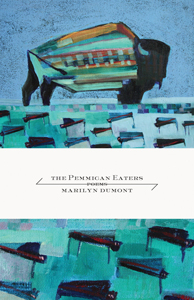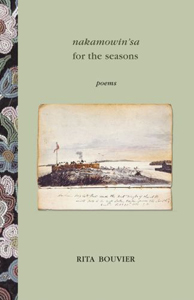Reviews
Poetry Reviews by Heather Jessup
Marilyn Dumont, The Pemmican Eaters (Toronto: ECW, 2015). Paperbound, 96 pp., $18.95.
Rita Bouvier, nakamowin’sa for the seasons (Saskatoon: Thistledown, 2015). Paperbound, 80 pp., $17.95.
American Poet Laureate Felipe Herrera once declared that “Poetry is a call to action and it also is action.” A good poem is performed on the page, but also comes to life through its readers. Similarly, when the Truth and Reconciliation Commission of Canada submitted its final report to Ottawa on December 15, 2015, in order to create better future relationships and further understanding between settler and Indigenous peoples, it did so not with suggestions but with ninety-four Calls to Action. Both Marilyn Dumont’s The Pemmican Eaters and Rita Bouvier’s nakamowin’sa for the seasons are poetry collections that are acts and calls to action.
 Marilyn Dumont’s The Pemmmican Eaters brings the truths of Canada’s colonial history into a contemporary postmodern voice. The collection takes the stuff of textbook photographs and academic appendixes, and sets the figures into movement—a Red River jig of hybridity and complexity. A series of linked cycles depict the resilient traditions and powerful resistance upheld by the Métis against a series of manoeuvres by the Canadian government to deny a distinct people their heritage, land, and language. Through “Our Gabriel,” an engaging essay that opens the collection, the poet tells the story of discovering a genealogical link between her family and the famed Métis leader Gabriel Dumont. Her autobiographical ties to history write the past into the present through distinct images: the rosined bow of a fiddle; the depiction of a relative’s hands meticulously stitching seed beads into floral-patterned moccasins, where the dandelions, in their insouciant yellow, “ignore you completely.” The Mischif language, spoken most often and intimately when families wintered in tents and villages, is contrasted with the academic conference where the expert linguist on endangered languages “who can be bought by industry and government / to lead to our own destruction” is not invited on the panel. The poems share memories, a pemmican recipe, and tales of rebellion—all delivered with a tone of both delicacy and brutality.
Marilyn Dumont’s The Pemmmican Eaters brings the truths of Canada’s colonial history into a contemporary postmodern voice. The collection takes the stuff of textbook photographs and academic appendixes, and sets the figures into movement—a Red River jig of hybridity and complexity. A series of linked cycles depict the resilient traditions and powerful resistance upheld by the Métis against a series of manoeuvres by the Canadian government to deny a distinct people their heritage, land, and language. Through “Our Gabriel,” an engaging essay that opens the collection, the poet tells the story of discovering a genealogical link between her family and the famed Métis leader Gabriel Dumont. Her autobiographical ties to history write the past into the present through distinct images: the rosined bow of a fiddle; the depiction of a relative’s hands meticulously stitching seed beads into floral-patterned moccasins, where the dandelions, in their insouciant yellow, “ignore you completely.” The Mischif language, spoken most often and intimately when families wintered in tents and villages, is contrasted with the academic conference where the expert linguist on endangered languages “who can be bought by industry and government / to lead to our own destruction” is not invited on the panel. The poems share memories, a pemmican recipe, and tales of rebellion—all delivered with a tone of both delicacy and brutality.
In “Not a Single Blade,” Gabriel Dumont is brightly drawn, stalking through the prairies, following “Les Anglais’ patrols searching Batoche / as morning light glints off their gun barrels / and their horses breath signalling the direction of their advance.” The poem introduces Dumont’s losses that have led him to this moment—“after the death of your uncle, Aicawpow, in battle / after the troops set fire to your house and stable / after they confiscate your prized herd of horses and your billiard table”— with a compelling refrain: “Not a single blade / of grass on the prairie / you do not know / not a single blade / will betray and / reveal your whereabouts.” Dumont’s dramatic role in the Riel Rebellion is juxtaposed with the graceful tenacity of “the dogwood lining the South Saskatchewan” and of the arc and bend of buffalo grass.
 In Rita Bouvier’s nakamowin’sa for the seasons the poems drift through different seasons of the year and through different geographies, all with a contemporary eye and an underpinning of wonder. An unnamed narrator—simply “she”—acts as an observer and wanderer in the poems, focusing the reader’s gaze. She often finds herself witnessing people who are at first outsiders but who then become intimates. In the poem “at Granville and West Georgia” a man wearing “a coat of many colours and flowing ribbons … is feeding birds and gazing at the building and clouds.” The man is dancing amongst people holding onto their morning coffees who “pretend not to notice him or each other.” The narrator wonders “why we are so afraid to make eye contact // she thinks: maybe we are afraid / to fall into that deep dark well— recognition. / our differences kaleidoscopic—of one light.” In “stopping for eternity” our narrator “meanders the paved foot path / along English Bay in Stanley Park / sunset dreaming” when she comes across a man standing at the shoreline “rocking back and forth; roses in his arms.” The man sets the roses adrift in the water, his mourning mysterious but acute. As he “finally lets go / she wondered if it was true / that we see things as we are / and not really as they are. // and, then unannounced—/ a sudden release of pain— so close, it just missed her heart.” The narrator’s wonder opens her to beauty but also to pain. In the Calgary airport en route to Saskatoon, the stereotypes of Aboriginal-themed items for sale bring her to tears; the “new-aged sounds of nature,” the “pretty mukluked brown faced doll dream catching,” and “the Indian head-dressed next to the Inukshuk / are made in China, / for God’s sake.” Our narrator calms herself: “take flight and just remember: / what is not for sale.”
In Rita Bouvier’s nakamowin’sa for the seasons the poems drift through different seasons of the year and through different geographies, all with a contemporary eye and an underpinning of wonder. An unnamed narrator—simply “she”—acts as an observer and wanderer in the poems, focusing the reader’s gaze. She often finds herself witnessing people who are at first outsiders but who then become intimates. In the poem “at Granville and West Georgia” a man wearing “a coat of many colours and flowing ribbons … is feeding birds and gazing at the building and clouds.” The man is dancing amongst people holding onto their morning coffees who “pretend not to notice him or each other.” The narrator wonders “why we are so afraid to make eye contact // she thinks: maybe we are afraid / to fall into that deep dark well— recognition. / our differences kaleidoscopic—of one light.” In “stopping for eternity” our narrator “meanders the paved foot path / along English Bay in Stanley Park / sunset dreaming” when she comes across a man standing at the shoreline “rocking back and forth; roses in his arms.” The man sets the roses adrift in the water, his mourning mysterious but acute. As he “finally lets go / she wondered if it was true / that we see things as we are / and not really as they are. // and, then unannounced—/ a sudden release of pain— so close, it just missed her heart.” The narrator’s wonder opens her to beauty but also to pain. In the Calgary airport en route to Saskatoon, the stereotypes of Aboriginal-themed items for sale bring her to tears; the “new-aged sounds of nature,” the “pretty mukluked brown faced doll dream catching,” and “the Indian head-dressed next to the Inukshuk / are made in China, / for God’s sake.” Our narrator calms herself: “take flight and just remember: / what is not for sale.”
The poems in nakamowin’sa offer a contemporary, peripatetic, and urban Aboriginal perspective, yet reflect on the author and narrator’s Métis identity and history. Hagiography and Catholic ritual are inflected with Cree and Cree-Michif language and traditions. In “on the seventh day” the Sunday rituals of a post-church picnic and the layering of willow boughs as both “spice for the gods” and to cook potatoes, bannock, and freshly-caught pike over an open fire, mingle together with a meal so perfect that the poem ends with the line “to heaven we will surely go.” The history of Christian and Indigenous spiritualties is also reflected in four poems dedicated to the history of Residential Schools—part of Canadian history now recognized by the United Nations as an act of cultural genocide.
In the poem “remembering Charlie” found words from the cbc documentary Dying for an Education blend with the author’s to offer remembrance to Charlie Wenjack of the Marten Falls First Nation. His body was found beside railway tracks on October 23, 1966. He was attempting to walk 600 miles back to his home after running away from the Cecelia Jeffrey Indian Residential School. In “reconciliation — a found poem,” Bouvier reflects on her experience of returning home to her community of Île-à-la-Crosse to attend a homecoming where the Oblates of Mary Immaculate issued a statement of apology to all who were present, and gave each individual a rose as an offering: “the past years have been painful / for priests and religious alike, individuals and families / coming to terms with injustice—abuse, accusation and allegation. there is a burning desire to be set free from what enslaves us. there is an urgent need for healing and forgiveness.” These lines echo the final poem in the collection, “truth,” which circles back to the opening lines of the opening poem in the collection “how do we hold silence / in lines of poetry.” The last poem calls out in response to the first: “we were taken from our mother; / they called her le savage, / cut our hair … how do we begin to describe no gentle embrace from a mother / where do we find the words?” The circularity of the collection shows a kind of grief in its repetition, but also transformation.
—Heather Jessup









